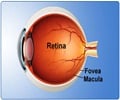People with inherited retinal degeneration have hope of vision since researchers have engineered cells in the eye to be light sensitive that were not before.
Zhuo-Hua Pan of Wayne State University School of Medicine and colleagues have engineered this technology using a harmless virus, they introduced a gene for a light-sensitive protein into "inner retinal neurons" in a strain of mice with photoreceptor deficiency that resembles the defect in such inherited human disorders as retinitis pigmentosa. The light-sensitive protein they used, called channelrhodopsin-2 (ChR2), is found in green algae.The introduced protein rendered the retinal neurons sensitive to light.
Writing a review of this paper from Neuron journal John Flannery and Kenneth Greenberg wrote,” With this strategy, the investigators have made a paradigm shift in the field and opened the possibility of genetically modifying the surviving retinal interneurons to function as a replacement light-sensing receptor. This publication is clearly a significant first step into this new field of re-engineering retinal interneurons as genetically modified 'prosthetic' cells.”
Still the researchers said that they have not yet determined whether the light signals reaching the visual cortex could be interpreted as vision and also the algal protein is less sensitive to light than is the normal light-detecting protein in the eye. Therefore they stress more work in this area.
The researchers say, "The remodeling of inner retinal neurons triggered by photoreceptor degeneration has raised some concerns for the retinal-based rescue strategy after the death of photoreceptors. However, retinal degenerative diseases are heterogeneous as to the time course of the degeneration, survival cell types, and, possibly, their functional state. Therefore, further studies are required to evaluate what types of retinal degenerative diseases and/or what disease stages are suitable for this potential treatment strategy. An important advantage of the strategy sought in this study is that it does not involve the introduction of tissues or devices into the retina and, therefore, may largely avoid the complications of immune reactions and biocompability. In addition, it could potentially achieve high spatial resolution for the restored 'vision' because the approach targets the cellular level. Thus, the expression of microbial-type channelrhodopsins, such as ChR2, in surviving retinal neurons may be another potential strategy for the treatment of complete blindness caused by rod and cone degeneration.”






